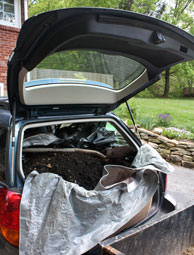
Photo by Sarah Dorroh Sweeney
The Incredible Food Show in Lexington, Ky., featured cooking demonstrations by Kentucky chefs. |
The secret is out—the people who bring you Hobby Farms and Hobby Farm Home magazines are die-hard foodies. So when the Incredible Food Show came to town, you know we were there. The more than 100 vendors at the show celebrated food grown, produced and sold in Kentucky, including cheeses, barbecue sauces, cakes, wines and more. We attended cooking demonstrations and producer seminars, and to get you in on the action, we’ve highlighted some of our favorite foods and tips.
Lisa Munniksma – Editor, Hobby Farms
Best of Show: Coal Country Beeworks Honey
Honey seems like an odd thing to choose as best in show, but Coal Country Beeworks honey tasted so sweet and balanced—exactly how I think honey should taste. Plus, it has a sweet story: CCB director Tammy Horn, PhD, of the Eastern Kentucky Environmental Research Institute, plants pollinator-friendly trees and flowers on reclaimed mine sites to develop a commercial honey industry in Appalachia and strengthen the bee population in the region. The honey is a delicious byproduct of her work.
Kitchen Tip: “Some of the best cheeses in the world stink, and that’s OK,” says Pat Wylie, cheesemonger for Good Foods Market & Café in Lexington, Ky. The trick is to know the difference between a good “stink” and a bad one. Cheese with an ammonia smell is not good. Wylie suggests letting the cheese sit for a little while, and if the smell doesn’t go away, throw it out.
When storing cheese, to prevent it from picking up odors and tastes from other food (such as onions or fish) in your fridge, wrap the cheese in wax paper or cheese paper, and put it inside a sealed plastic bag. Don’t wrap the cheese in plastic wrap for long-term storage, as the plastic will impart a petroleum-plastic taste.
Producer’s Tip: Jim Mansfield of New American Lamb in Salvisa, Ky., encourages small-scale farmers to get in on the mutton and lamb market. He says this is a great because meat prices are high, there is rising consumer demand—particularly from the ethnic market—and there are fewer producers raising sheep. Farmers should become involved with their local or state sheep associations and can form cooperatives with other producers to have a larger presence in the market.
Stephanie Staton – Editor, Hobby Farm Home
Best of Show: Howard’s Creek Authentic Beer Cheese
I love beer cheese, and this brand is the perfect blend of mild flavor followed by a slight heat. It reminds me of Sunday lunches with my family at Hall’s on the River, one of our favorite restaurants in Winchester, Ky.
Kitchen Tip: Reserve ¼ cup of pasta water after cooking, says celebrity Chef Giada De Laurentiis. Use it to add moisture back into sauces or to help grated cheeses, such as Parmesan, stick to the pasta. The natural starches in the pasta water work to break up sauces that are too thick.
Sarah Dorroh Sweeney – Associate Editor, Hobby Farms and Hobby Farm Home
Best of Show: Good Foods Market and Café’s Lavender Shortbread Cookies/Shell-Bee’s Gourmet Sea Salts & Spices
Do I have to pick just one favorite? After all of my taste-testing, the lovely lavender shortbread cookies were supposed to be my first and only purchase at the show. Dusted with sugar and speckled with organic lavender blossoms—the smell and taste was divine. However, Shell-Bee’s selection flavor-infused Demerara sugar was hard to pass up. This sugar, derived from an island off the coast of Africa, has only recently been made available in the U.S. My personal favorite is the Vanilla Bean & Lavender. Lucky for me, the two make a heavenly combination!
Kitchen Tip: The key to a successful cake is finding a recipe that combines taste with artistry, say the chefs at Sullivan University. For sculpture decorations, choose a material that isn’t too heavy or too wet. Try molding rice cereal treats into your desired shape and then cover that with a thin layer of marzipan, especially for decorative pieces larger than 1 inch. Then use your decorations to cover any flaws.
Gardener’s Tip: Take this tip from Barbara Napier, Innkeeper of Snug Hollow Farm, a bed and breakfast on 300 acres: When planning your garden, “grow what you’re gonna eat, grow what you’re gonna love.” There’s no sense planting row after row of produce that neither you nor your family is going to enjoy.
Rachael Brugger – Associate Web Editor, HobbyFarms.com
Best of Show: Edward Lee’s Butternut Squash Soup
I may need to roadtrip to 610 Magnolia in Louisville, Ky., just for another taste of this creamy soup. Instead of using butter or cream, Chef Edward Lee creates his own butternut stock using the squash’s skin, seeds and netting, and purees that with his roasted squash. To balance the soup’s sweet creaminess, he garnishes it with country ham, Brussels sprout leaves, chopped dried figs and blue corn hominy—all grown locally!
Kitchen Tip: For a stress-free Sunday supper or holiday meal, freeze your appetizers ahead of time to minimize your kitchen responsibilities the day of your meal. But beware, says Chef Allyson Butcha, who serves up meals to Kentucky’s first family—don’t leave your tasty treats in the freezer too long. Contrary to what most people think, freezing food actually dries it out. So if you need to keep a few courses in the freezer prior to the big meal, keep the time limited.
















